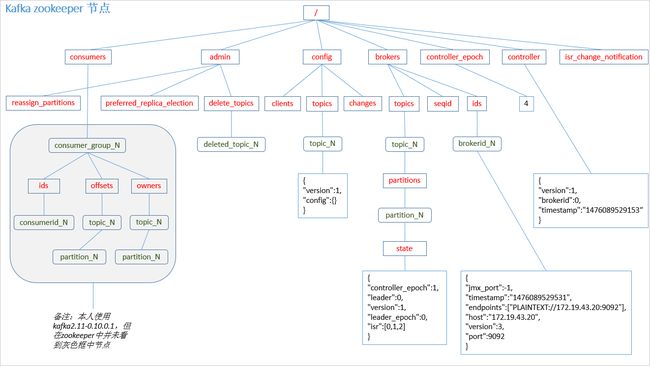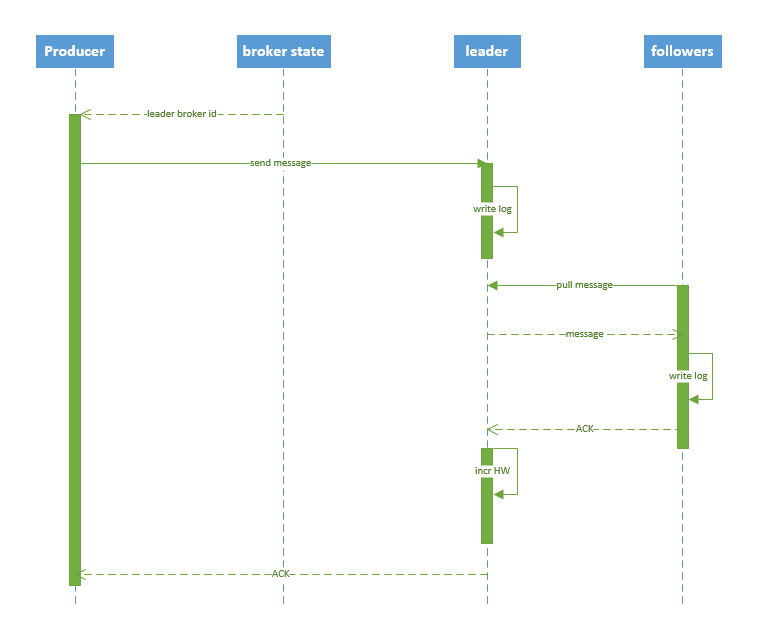kafka学习笔记:知识点整理(一)
一、kafka 架构
1.1 拓扑结构
如下图:
图.1
1.2 相关概念
如图.1中,kafka 相关名词解释如下:
1.producer: 消息生产者,发布消息到 kafka 集群的终端或服务。 2.broker: kafka 集群中包含的服务器。 3.topic: 每条发布到 kafka 集群的消息属于的类别,即 kafka 是面向 topic 的。 4.partition: partition 是物理上的概念,每个 topic 包含一个或多个 partition。kafka 分配的单位是 partition。 5.consumer: 从 kafka 集群中消费消息的终端或服务。 6.Consumer group: high-level consumer API 中,每个 consumer 都属于一个 consumer group,每条消息只能被 consumer group 中的一个 Consumer 消费,但可以被多个 consumer group 消费。 7.replica: partition 的副本,保障 partition 的高可用。 8.leader: replica 中的一个角色, producer 和 consumer 只跟 leader 交互。 9.follower: replica 中的一个角色,从 leader 中复制数据。 10.controller: kafka 集群中的其中一个服务器,用来进行 leader election 以及 各种 failover。 12.zookeeper: kafka 通过 zookeeper 来存储集群的 meta 信息。
1.3 zookeeper 节点
kafka 在 zookeeper 中的存储结构如下图所示:
图.2
二、producer 发布消息
2.1 写入方式
producer 采用 push 模式将消息发布到 broker,每条消息都被 append 到 patition 中,属于顺序写磁盘(顺序写磁盘效率比随机写内存要高,保障 kafka 吞吐率)。
2.2 消息路由
producer 发送消息到 broker 时,会根据分区算法选择将其存储到哪一个 partition。其路由机制为:
1. 指定了 patition,则直接使用; 2. 未指定 patition 但指定 key,通过对 key 的 value 进行hash 选出一个 patition 3. patition 和 key 都未指定,使用轮询选出一个 patition。
附上 java 客户端分区源码,一目了然:
//创建消息实例 public ProducerRecord(String topic, Integer partition, Long timestamp, K key, V value) { if (topic == null) throw new IllegalArgumentException("Topic cannot be null"); if (timestamp != null && timestamp < 0) throw new IllegalArgumentException("Invalid timestamp " + timestamp); this.topic = topic; this.partition = partition; this.key = key; this.value = value; this.timestamp = timestamp;
} //计算 patition,如果指定了 patition 则直接使用,否则使用 key 计算 private int partition(ProducerRecord record, byte[] serializedKey , byte[] serializedValue, Cluster cluster ) {
Integer partition = record.partition(); if (partition != null) {
List partitions = cluster.partitionsForTopic(record.topic()); int lastPartition = partitions.size() - 1; if (partition < 0 || partition > lastPartition) { throw new IllegalArgumentException(String.format("Invalid partition given with record: %d is not in the range [0...%d].", partition, lastPartition));
} return partition;
} return this.partitioner.partition(record.topic(), record.key(), serializedKey, record.value(), serializedValue, cluster);
} // 使用 key 选取 patition public int partition(String topic, Object key, byte[] keyBytes, Object value, byte[] valueBytes, Cluster cluster) {
List partitions = cluster.partitionsForTopic(topic); int numPartitions = partitions.size(); if (keyBytes == null) { int nextValue = counter.getAndIncrement();
List availablePartitions = cluster.availablePartitionsForTopic(topic); if (availablePartitions.size() > 0) { int part = DefaultPartitioner.toPositive(nextValue) % availablePartitions.size(); return availablePartitions.get(part).partition();
} else { return DefaultPartitioner.toPositive(nextValue) % numPartitions;
}
} else { //对 keyBytes 进行 hash 选出一个 patition return DefaultPartitioner.toPositive(Utils.murmur2(keyBytes)) % numPartitions;
}
}
2.3 写入流程
producer 写入消息序列图如下所示:
图.3
流程说明:
1. producer 先从 zookeeper 的 "/brokers/.../state" 节点找到该 partition 的 leader 2. producer 将消息发送给该 leader 3. leader 将消息写入本地 log 4. followers 从 leader pull 消息,写入本地 log 后 leader 发送 ACK 5. leader 收到所有 ISR 中的 replica 的 ACK 后,增加 HW(high watermark,最后 commit 的 offset) 并向 producer 发送 ACK
愿意了解更多技术分享的可关注:mingli.com
朋友需要请加球球:二零四二八四九二三七
2.4 producer delivery guarantee
一般情况下存在三种情况:
1. At most once 消息可能会丢,但绝不会重复传输 2. At least one 消息绝不会丢,但可能会重复传输 3. Exactly once 每条消息肯定会被传输一次且仅传输一次
当 producer 向 broker 发送消息时,一旦这条消息被 commit,由于 replication 的存在,它就不会丢。但是如果 producer 发送数据给 broker 后,遇到网络问题而造成通信中断,那 Producer 就无法判断该条消息是否已经 commit。虽然 Kafka 无法确定网络故障期间发生了什么,但是 producer 可以生成一种类似于主键的东西,发生故障时幂等性的重试多次,这样就做到了 Exactly once,但目前还并未实现。所以目前默认情况下一条消息从 producer 到 broker 是确保了 At least once,可通过设置 producer 异步发送实现At most once。
来自 “ ITPUB博客 ” ,链接:http://blog.itpub.net/31456321/viewspace-2139723/,如需转载,请注明出处,否则将追究法律责任。
转载于:http://blog.itpub.net/31456321/viewspace-2139723/


